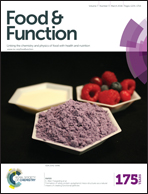Effects of waxy rice starch and short chain amylose (SCA) on the formation of 2-amino-1-methyl-6-phenylimidazo[4,5-b]pyridine (PhIP) in a model system
Abstract
Starch is a glucose polymer of vast importance to mankind. It forms the major component of all our staple foods. Starch is often used as an important material in cooking meat. In this study, the effects of waxy rice starch and short chain amylose (SCA) from debranched waxy rice starch on the formation of PhIP in a model system were investigated and compared. The results showed that the addition of waxy rice starch and SCA significantly decreased PhIP, and the effect of SCA was more pronounced than that of waxy rice starch. This decrease may be attributed to the fact that the glucose residues of starch condense with the amino group of the creatinine formed N-glycosyl conjugate. This reaction path could disturb the reaction of creatinine with phenylacetaldehyde, subsequently influence the aldol condensation product formation, and finally suppress the formation of PhIP. Furthermore, the complex spatial structure of waxy rice starch disturbs the reaction of the glucosyl hydroxyl groups of glucose with the amino group of creatinine in the model reaction. So the effect of SCA was more pronounced than that of waxy rice starch on suppressing PhIP formation. A possible mechanism of waxy rice starch and SCA for inhibiting PhIP formation in the model system is also proposed.
![Graphical abstract: Effects of waxy rice starch and short chain amylose (SCA) on the formation of 2-amino-1-methyl-6-phenylimidazo[4,5-b]pyridine (PhIP) in a model system](/en/Image/Get?imageInfo.ImageType=GA&imageInfo.ImageIdentifier.ManuscriptID=C5FO01495F&imageInfo.ImageIdentifier.Year=2016)

 Please wait while we load your content...
Please wait while we load your content...